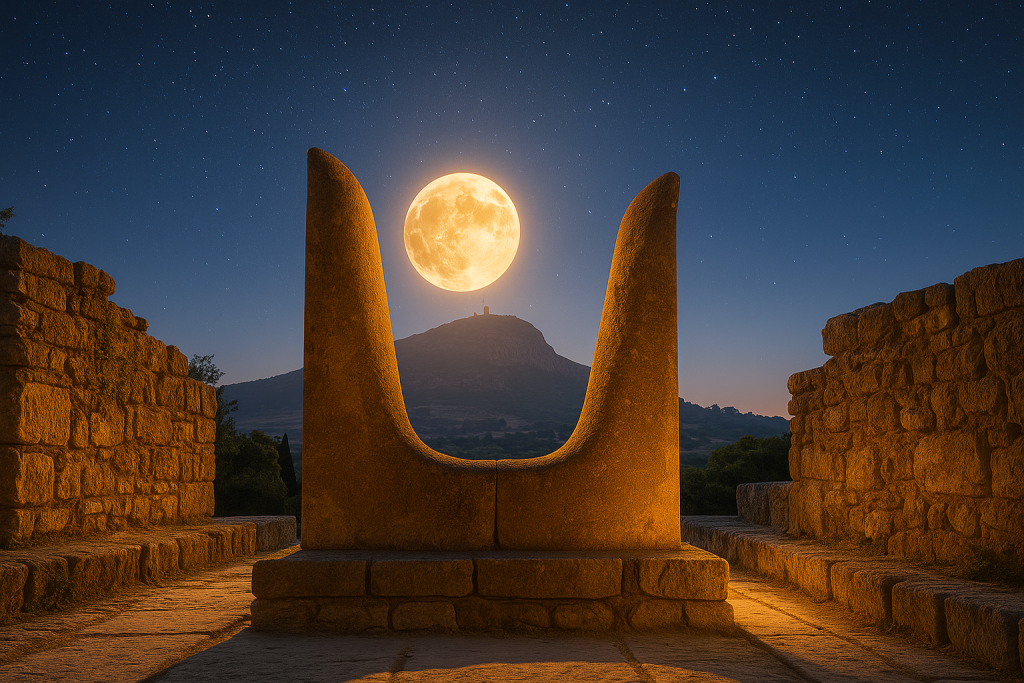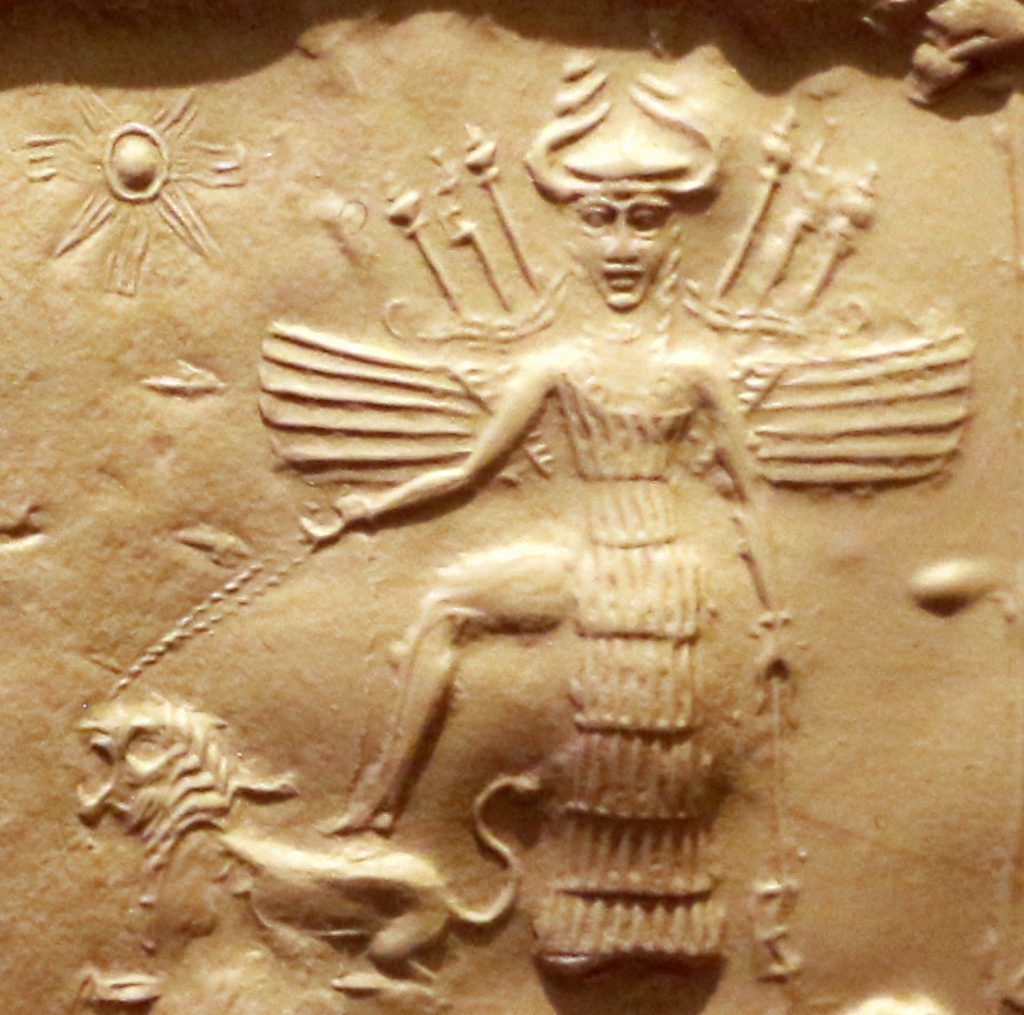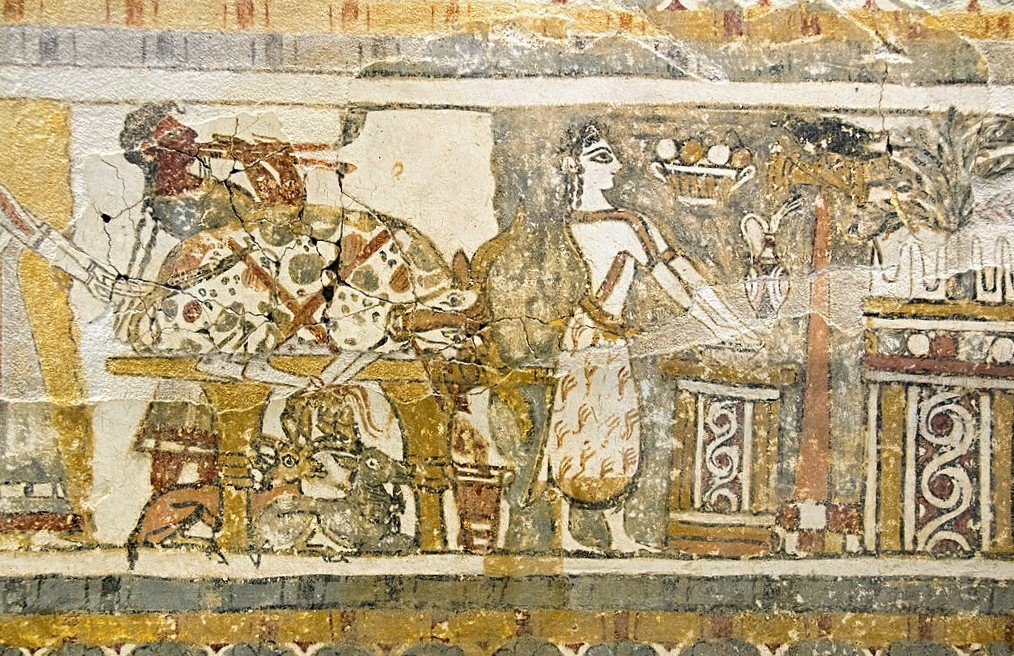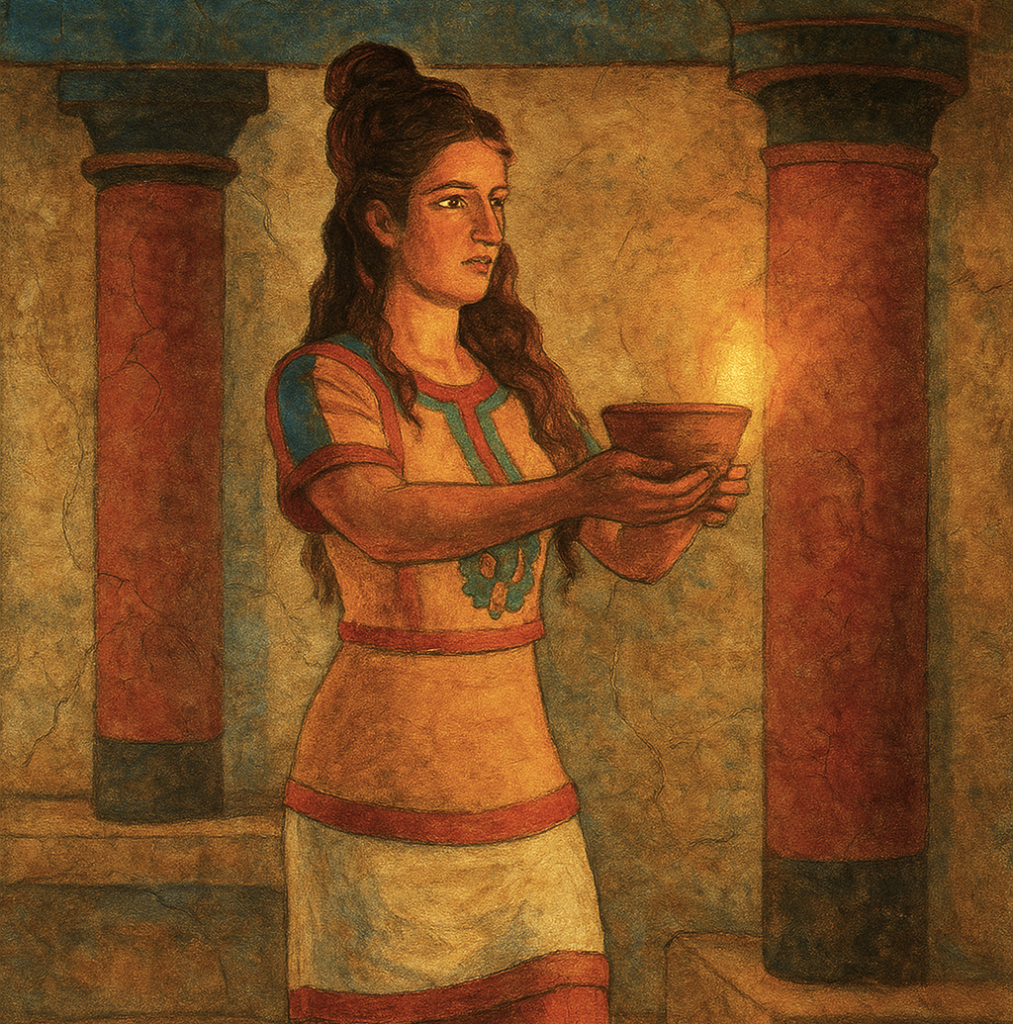Were the Keftiu “horns of consecration” astronomical instruments as well as sacred symbols? This richly illustrated exploration follows the full moon over Mount Juktas, linking Astarte, Inanna, Potnia Theron, and Ariadne in a ritual alignment of sky, myth, and stone.
Across the Bronze Age world, few symbols are as enigmatic-or as potent—as the “horns of consecration” found throughout Minoan Crete. Often interpreted as stylized bull horns, they crown altars, frescoes, and palace parapets. But what if they are more than religious ornamentation? What if, at a precise astronomical moment, the moon itself appears to rise within them—transforming stone into a cosmic vessel?
The Goddess in Transit
Astarte—goddess of fertility, war, and the evening star—is often depicted traveling in a double-ended boat. Some scholars have proposed that this motif represents her celestial voyage from the Levant to the Aegean, a spiritual migration that may have reached Crete. The boat, intriguingly, mirrors the form of the Minoan horns: twin curves, symmetrical, part beast, part womb.
When viewed under specific conditions—especially during a full moon low on the horizon—the horns of consecration may frame the moon perfectly, creating a visual echo of the goddess herself riding the sky. The image becomes not just symbolic, but experiential—a sacred moment embedded in landscape and architecture.

A Celestial Framing Over Mt. Juktas
One caveat must be considered: the current placement of the horns of consecration at Knossos may not precisely reflect their original orientation. The present configuration, reconstructed during the extensive restorations under Arthur Evans, may be artistically inspired or symbolic rather than astronomically exact. If Evans misunderstood the ritual significance or altered the spatial dynamics of the court, the actual point of alignment for lunar rituals may differ.
It is plausible—if not likely—that the ideal viewing position was located slightly apart from the horns themselves, perhaps from a platform or ritual station where a priestess would stand during full moon ceremonies. In fact, based on the angles of elevation required to see the moon perfectly framed atop Mount Juktas through the horns—often 30 degrees or more—it is conceivable that the horns were originally elevated much higher than their present state.
Evidence suggests that a taller structure or building once stood beneath the horns, now lost or partially restored. If true, this would have elevated the horns significantly, making the lunar alignment possible from a deliberate ceremonial vantage. Without this height, the alignment would only be visible from an awkwardly close or artificially raised perspective, which supports the idea that what we see today is a reconstruction that may obscure original architectural and ritual design.
From such a high vantage or elevated structure, the line of sight could more naturally frame the moon as it rose over Mount Juktas, preserving the symbolic and astronomical integrity of the ritual alignment.
At Knossos, many of the most iconic horns face south—toward Mount Juktas, the sacred mountain believed to represent the resting body or face of a god. If, at a key moment—likely near the solstice—the full moon rises low on the southern horizon, it may appear to nest between the horns, perfectly framed, with Juktas as the cosmic backdrop.
Measurements from the central court suggest that the horns—at least in their current reconstructed positions—would frame a celestial object positioned approximately 10 to 20 degrees above the horizon. The moon, rising at or near this angle during the summer solstice full moon, would sit visually within the horns, completing the ritual image: a luminous goddess ascending from the sacred mountain, born anew in light and stone.
This would not be a high moon in transit across the sky, but a moon caught in its moment of emergence—a luminary seated in the cradle of the horns, as though sailing slowly from the underworld to the realm of the divine.

Such a phenomenon would align with ritual timing, mythic narrative, and architectural design. The horns become a portal, the moon a deity, and Juktas the witness—all three bound in a single act of sacred choreography.
Astral Engineering?
Some scholars have proposed that Linear A, the undeciphered script of the Minoans, may share roots with or have been influenced by Near Eastern writing systems, including cuneiform traditions from Mesopotamia. There is even limited evidence that Akkadian was used in attempts to translate Linear A inscriptions, hinting at a cultural or diplomatic interface between Crete and the East. If true, this would reinforce the idea that the Minoan ritual and cosmological vocabulary was not insular, but part of a wider Bronze Age sacred and linguistic matrix, where symbols, gods, and celestial narratives flowed between civilizations.
Echoes of a Forgotten Link
While modern archaeology often views Minoan religion in an Aegean vacuum, there is compelling reason to believe that the earliest manifestations of the horns of consecration may be linked to Mesopotamian iconography—perhaps as early as Babylonian religious architecture. The twin horns, echoing the crescent of the moon god Sin, and the Minoan emphasis on gateways, lunar presence, and divine emergence suggest more than coincidence. Though much has been lost, fragments of this symbolic thread persist—threads first noticed by early researchers, and now ready to be re-woven into a wider sacred history.
The possibility of symbolic or mythological connections beyond the Aegean should not be overlooked. The Minoans—known as the Keftiu in Egyptian records—maintained maritime and cultural contact with Egypt, the Levant, and potentially even Mesopotamia. Notably, the composition of the Minoan pantheon remains a subject of heated debate and ongoing study, with many deities—particularly goddesses—appearing in multiple forms and under varied influences. This uncertainty opens space for interpretive connections across regions and mythologies. Given the lunar and celestial symbolism in the rites proposed here, it’s possible that Minoan ritual structures and their astronomical alignments were influenced by, or in dialogue with, Mesopotamian traditions—particularly those centered on the moon, sacred gates, and divine descent. The horns of consecration themselves may echo the crescent iconography common in Mesopotamian religious art, where the moon was not just a timekeeper, but a divine traveler between worlds. Minoan palaces are not randomly oriented. As explored in studies of Knossos, Phaistos, and Zakros, the central courts and ritual spaces are aligned with solar events, lunar extremes, and star risings. The possibility that the horns themselves were positioned to frame astronomical events is compelling. Like Egyptian temple gateways that frame the sun on equinox mornings, the horns of Crete may function as celestial apertures.

Could it be that at specific times of year—perhaps tied to the lunar octaeteris or the heliacal rising of Venus—the moon appeared poised between these sculpted forms? Such a vision would be nothing short of divine: Astarte crossing the heavens in her double-ended boat, emerging from stone, riding light.
Ritual of Light and Stone
Imagine a priestess at Knossos, watching the moon rise between the horns as temple torches flicker and Mount Juktas looms in silhouette. To modern minds, it is symbolism. To ancient ones, it was presence. A goddess made real through the choreography of architecture, light, and landscape.
This hypothesis, though speculative, invites us to see Minoan sacred space not just as static artifact—but as dynamic stage. The horns were not inert. They were frames. They were vessels. They were waiting for the goddess to arrive.
Festival of Ascent: The Moon as Festival Marker
Some aspects of this ritual vision echo older mythic templates—perhaps none more striking than the Sumerian tale of Inanna’s descent and return from the underworld. Inanna, like Astarte, was a goddess of love, fertility, and war, who descended into the land of the dead, was stripped of her power, and later resurrected. She is often shown wearing a horned headdress, a marker of divine authority that visually echoes the Minoan horns of consecration. Her garments, too, bear a striking resemblance to the flounced skirts and cinched waists of Minoan priestesses. In one particularly evocative relief, she holds a griffon on a leash—a creature deeply associated with Minoan iconography. Inanna, like Astarte, was a goddess of love, fertility, and war, who descended into the land of the dead, was stripped of her power, and later resurrected. Her journey mirrors the cycle of the moon: disappearance, darkness, and brilliant reemergence.

This motif resonates strongly with Cretan mythology, where Minos and his brother Rhadamanthys were said to be judges or gatekeepers of the dead in the underworld. It invites us to consider that Inanna may have had a Minoan counterpart—perhaps not in name, but in form and function. Some scholars have speculated that the so-called “Snake Goddess” figurines, or high-ranking Minoan priestesses depicted in flounced skirts with uplifted arms, may represent a **native lunar-fertility deity—perhaps remembered later as Potnia Theron—or even embodied in the legendary Pasiphaë, whose association with bull imagery, moon magic, and Near Eastern resonance deepens the link—**who mirrored Inanna’s attributes: cyclical death and return, connection to the earth, and ritual power. Another compelling candidate is Ariadne, daughter of King Minos and mistress of the labyrinth, who has also been associated with the moon. Some interpretations of Linear B tablets found at Knossos suggest Ariadne may have had a cultic or divine status, and her mythic role as a guide through the labyrinth mirrors the moon’s guiding light and cyclical journey. If so, then the rising of the full moon from behind Mount Juktas, through the horns of consecration, could be seen not only as a celestial event, but as a mythic reenactment—a goddess ascending from death, through the judgment of Minos, into the world of the living.
The moon doesn’t simply rise—it returns. And that return may have signified not just seasonal renewal, but a metaphysical one: a release, a blessing, a second chance. The phase of the moon has always been a natural timekeeper, but for the Keftiu—like many ancient peoples—it likely carried layers of agricultural, spiritual, and ritual significance. The full moon, especially when low on the horizon and visually framed by sacred architecture, could have served as a marker for major festivals tied to fertility, renewal, and divine visitation.
In Minoan Crete, the low full moon near the summer solstice may have heralded the peak of growth before harvest—a moment of cosmic fullness, mirrored in the lunar cycle and in the ripening earth. The visual of the moon seated between the horns, low and luminous, could symbolize the goddess in her fertile aspect, descending to bless the land or receive offerings from mortals.

This celestial event may have been tied to festivals involving dance, offerings, and ecstatic ritual, conducted under moonlight in palace courts. It is possible the Minoans timed such events according to a lunar calendar, perhaps using the octaeteris (eight-year lunar cycle) known from later Greek traditions but rooted in earlier Bronze Age observations.
A low full moon, emerging just above Mount Juktas and crowned in the horns, would have embodied not just the return of divine presence to the world of the living—but the beginning of her ascent. It marked the first visible step in the moon’s climb toward the heavens, following the solstice, echoing both agricultural ripening and spiritual elevation.
We may call this hypothetical observance the Festival of Ascent—a celebration of the goddess in her moment of luminous emergence, a cosmic declaration that the cycle of return had begun, and that all growth—within earth, body, and soul—was blessed to rise with her.
It was a moment where time, light, body, and cosmos synchronized in ceremony.
Final Thoughts
The horns of consecration may have crowned Minoan ritual spaces, but they also crowned the sky. If the moon passed through them—visually, symbolically, even ritually—then Astarte was more than myth. She was movement. She was alignment. She was the moon on her sacred boat.
And Crete, once again, becomes not just an island—but a portal.

